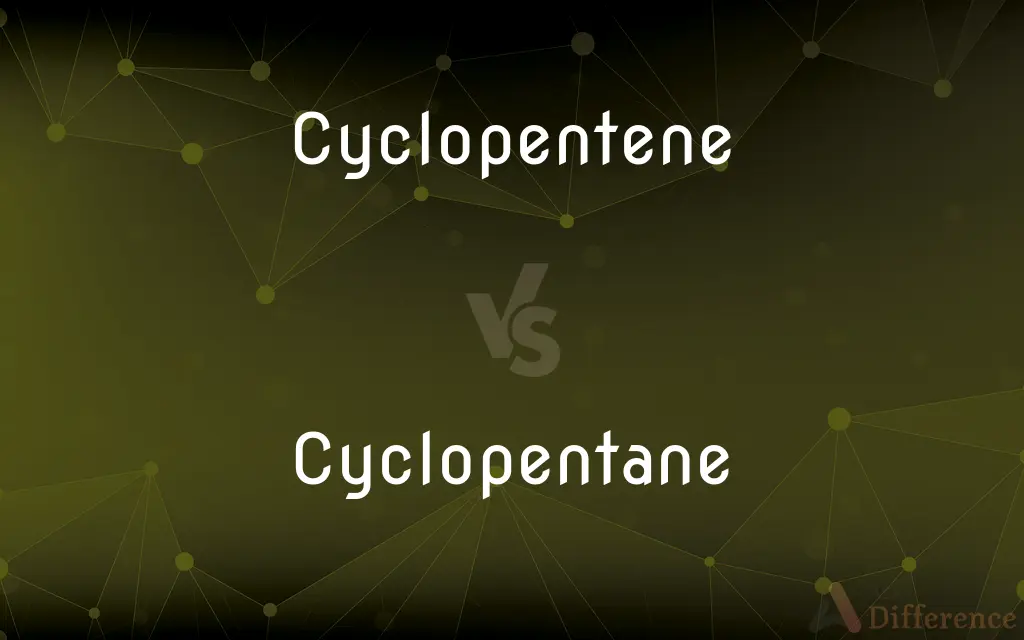Cyclopentene vs. Cyclopentane — What's the Difference?
By Urooj Arif & Maham Liaqat — Updated on March 11, 2024
Cyclopentene is a cyclic hydrocarbon with a carbon-carbon double bond, giving it unsaturated characteristics. Cyclopentane is a saturated cyclic hydrocarbon, lacking double bonds, making it more stable but less reactive than cyclopentene.

Difference Between Cyclopentene and Cyclopentane
Table of Contents
ADVERTISEMENT
Key Differences
Cyclopentene features a carbon-carbon double bond within its five-membered ring structure, categorizing it as an unsaturated hydrocarbon. This double bond introduces elements of reactivity and instability compared to saturated hydrocarbons, making cyclopentene more susceptible to reactions such as addition reactions, where reactants add to the double bond. Cyclopentane, with its single bonds between carbon atoms, is a saturated hydrocarbon, more stable and less reactive than its unsaturated counterparts.
The presence of the double bond in cyclopentene not only affects its chemical reactivity but also its physical properties. For example, the double bond can influence the boiling point, melting point, and solubility of the compound. Cyclopentane, being saturated and lacking such a double bond, typically exhibits different physical properties, such as a higher boiling point and melting point compared to cyclopentene, due to the lack of π-bonding.
Chemically, cyclopentene is more prone to undergo reactions that involve the opening or modification of the double bond, such as hydrogenation, where hydrogen is added to the compound, converting it into a saturated molecule. Cyclopentane, lacking such reactive sites, does not readily participate in such reactions, making it chemically less versatile than cyclopentene.
In terms of synthesis and applications, cyclopentene can be used as a starting material or intermediate in the synthesis of more complex chemical compounds, especially in the pharmaceutical and materials science fields. Its reactivity allows for the introduction of various functional groups. Cyclopentane, being less reactive, is often valued for its stability and is used in applications where a stable, non-reactive hydrocarbon is desired, such as in certain types of insulation or as a solvent.
The distinction between cyclopentene and cyclopentane highlights the broader differences between unsaturated and saturated hydrocarbons in organic chemistry, reflecting in their reactivity, stability, and applications in various industrial and research contexts.
ADVERTISEMENT
Comparison Chart
Bond Type
Unsaturated (contains a C=C double bond)
Saturated (contains only C-C single bonds)
Reactivity
More reactive due to the double bond
Less reactive, more stable
Chemical Reactions
Prone to addition reactions
Does not readily undergo addition reactions
Physical Properties
Generally lower boiling and melting points
Higher boiling and melting points due to saturation
Applications
Used in synthesis and manufacturing of chemicals
Used where chemical stability is required
Compare with Definitions
Cyclopentene
Lower boiling and melting points compared to cyclopentane.
The physical properties of cyclopentene are influenced by its unsaturation.
Cyclopentane
A saturated cyclic hydrocarbon with single bonds only.
Cyclopentane is less reactive than cyclopentene, making it more stable.
Cyclopentene
An unsaturated cyclic hydrocarbon with a double bond.
Cyclopentene is used as an intermediate in the synthesis of various chemicals.
Cyclopentane
Commonly used as a solvent and in insulation.
The stability of cyclopentane makes it ideal for use in certain industrial applications.
Cyclopentene
Used in the manufacture of polymers and pharmaceuticals.
Cyclopentene's reactivity is exploited in creating specialized polymers.
Cyclopentane
Does not exhibit geometric isomerism.
The absence of a double bond in cyclopentane means it lacks isomers based on bond orientation.
Cyclopentene
More reactive, making it suitable for diverse chemical reactions.
Cyclopentene undergoes addition reactions readily due to its double bond.
Cyclopentane
Generally has a higher boiling point than cyclopentene.
Cyclopentane's saturated structure leads to stronger intermolecular forces and a higher boiling point.
Cyclopentene
Can be hydrogenated to form cyclopentane.
Hydrogenation of cyclopentene yields cyclopentane, increasing its saturation.
Cyclopentane
Less prone to chemical reactions due to saturation.
The lack of a double bond in cyclopentane limits its reactivity.
Cyclopentene
Cyclopentene is a chemical compound with the formula (CH2)3(CH)2. It is a colorless liquid with a petrol-like odor.
Cyclopentane
Cyclopentane (also called C pentane) is a highly flammable alicyclic hydrocarbon with chemical formula C5H10 and CAS number 287-92-3, consisting of a ring of five carbon atoms each bonded with two hydrogen atoms above and below the plane. It occurs as a colorless liquid with a petrol-like odor.
Cyclopentene
(organic compound) A cycloalkene, C5H8; a colorless liquid with a petrol-like odor, used as a monomer for the synthesis of plastics.
Cyclopentane
A colorless, flammable, mobile liquid cycloalkane, C5H10, derived from petroleum and used as a solvent and motor fuel.
Cyclopentane
(organic compound) An alicyclic hydrocarbon, C5H10; a volatile inflammable liquid, sometimes used as a solvent.
Common Curiosities
Is cyclopentane reactive in the same way as cyclopentene?
No, cyclopentane is less reactive because it lacks the double bond present in cyclopentene, making it more resistant to chemical reactions.
Why is cyclopentane used as an insulation material?
Cyclopentane's stability and non-reactive nature make it suitable for use in insulation materials, where chemical inertness is desired.
What is the significance of geometric isomerism in cyclopentene?
Geometric isomerism in cyclopentene can lead to different physical and chemical properties, which is important in chemical synthesis and the study of organic compounds.
What makes cyclopentene more reactive than cyclopentane?
The presence of a carbon-carbon double bond in cyclopentene introduces unsaturation, making it more chemically active and capable of undergoing addition reactions.
What types of reactions is cyclopentene involved in?
Cyclopentene commonly participates in addition reactions, where atoms or molecules add across its double bond.
Why might a chemist choose cyclopentane over cyclopentene for a reaction?
A chemist might choose cyclopentane for reactions or applications requiring a stable, less reactive compound, such as when a non-reactive solvent is needed.
Can cyclopentene be converted into cyclopentane?
Yes, cyclopentene can be converted into cyclopentane through hydrogenation, where hydrogen is added across the double bond, saturating the molecule.
Are cyclopentene and cyclopentane isomers of each other?
They are structural isomers, sharing the same molecular formula but differing in the connectivity of their atoms due to the presence or absence of a double bond.
How does the boiling point of cyclopentene compare to that of cyclopentane?
Cyclopentene generally has a lower boiling point than cyclopentane due to its unsaturated structure, which affects intermolecular interactions.
How does the double bond in cyclopentene affect its chemical properties?
The double bond in cyclopentene makes it prone to reactions that open or modify the double bond, affecting its reactivity and the types of chemical reactions it can undergo.
What are the safety considerations when handling cyclopentene and cyclopentane?
Both compounds require careful handling due to their flammability and potential health effects if inhaled or ingested, necessitating proper safety precautions in storage and use.
Can the boiling points of cyclopentene and cyclopentane be used to separate them?
Yes, their differing boiling points can be exploited in distillation processes to separate cyclopentene from cyclopentane.
Are there environmental considerations in the use of cyclopentane?
Yes, cyclopentane's use, especially in foam insulation, is scrutinized for its potential environmental impact, including its role as a greenhouse gas when not properly contained.
How do the structures of cyclopentene and cyclopentane influence their physical properties?
The structural differences, particularly the presence of a double bond in cyclopentene, influence their intermolecular forces and, consequently, their boiling points and solubility.
Can cyclopentane participate in addition reactions like cyclopentene?
No, cyclopentane does not readily participate in addition reactions due to its saturated structure; it is more likely to undergo substitution reactions under certain conditions.
Share Your Discovery

Previous Comparison
Dwelling vs. Household
Next Comparison
Subsidence vs. SettlementAuthor Spotlight
Written by
Urooj ArifUrooj is a skilled content writer at Ask Difference, known for her exceptional ability to simplify complex topics into engaging and informative content. With a passion for research and a flair for clear, concise writing, she consistently delivers articles that resonate with our diverse audience.
Co-written by
Maham Liaqat














































